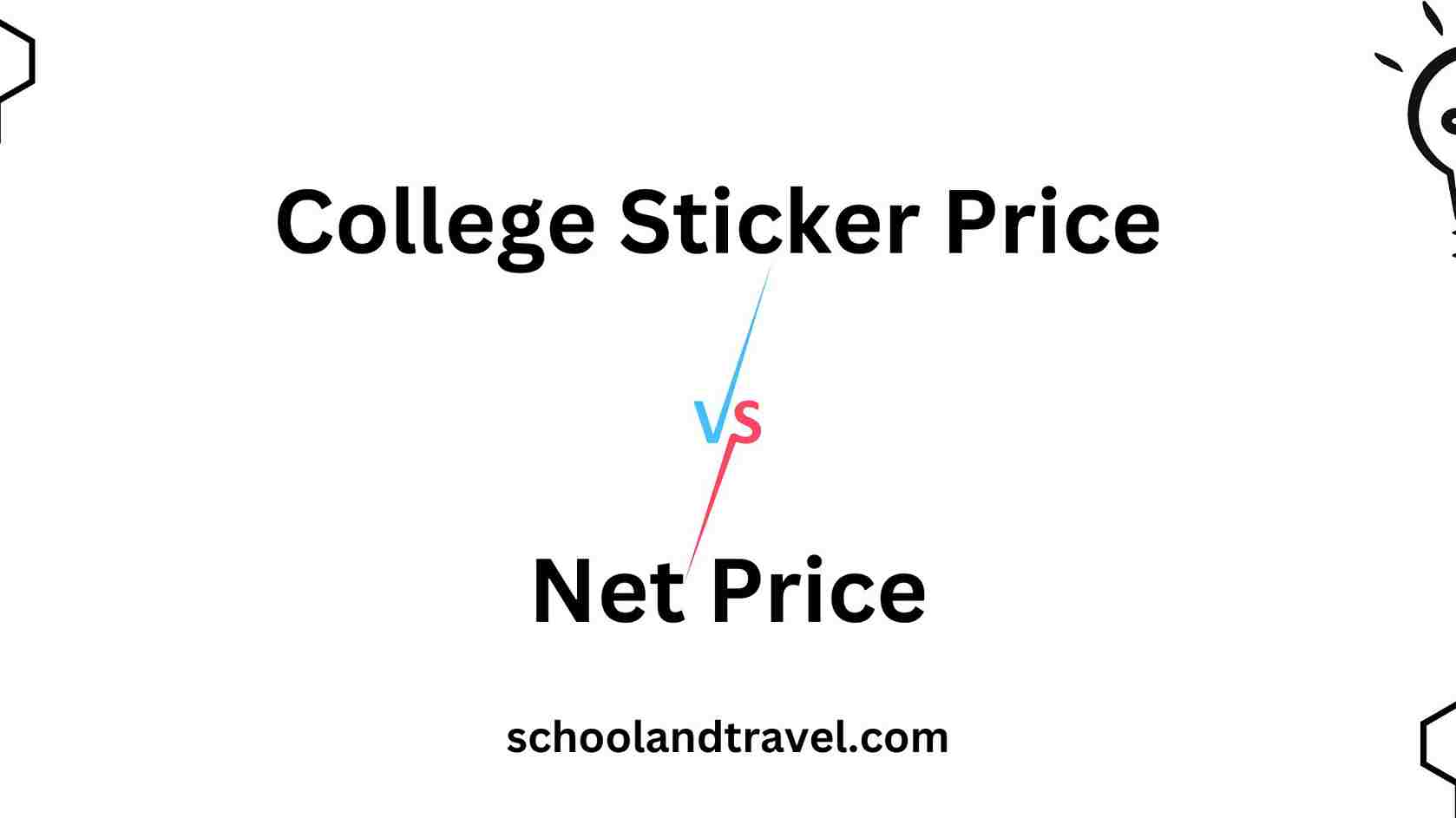When researching colleges/universities, you’ll often come across two basic terms: Sticker Price and Net Price.
Understanding the difference between these two is crucial for making informed financial decisions.
Let’s delve deeper into this topic and decipher the disparities between college Sticker Prices and Net Prices.
What is a Sticker Price for College?
The Sticker Price for college refers to the published cost of attendance set by a college or university.
It represents the total amount students are expected to pay for one year of education, including tuition, fees, room and board, textbooks, and other expenses.
The Sticker Price is a starting point for estimating the cost of attending a particular institution.
What is the Net Price for college?
Net Price for college refers to the actual amount that a student and their family are expected to pay for college after deducting financial aid and scholarships from the published Sticker Price.
It considers the student’s financial need, merit-based and institutional aid.
The Net Price provides a more accurate estimate of a student’s pay as it considers the specific financial circumstances and available resources.
Understanding the Net Price helps students and families make informed decisions about college affordability and allows for realistic financial planning.
How to Calculate College Net Price
Calculating the Net Price for college is an essential step in understanding the actual cost of attending a particular institution.
Here are some steps to help you calculate your Net Price:
1. Utilize the Net Price Calculator
Most colleges and universities have a Net Price Calculator on their website.
Access this tool and provide the requested information, such as family income, assets, household size, and academic achievements.
The calculator will then estimate your Net Price based on the institution’s financial aid policies and available scholarships.
2. Use the U.S. Department of Education Net Price Calculator
If you need help finding the Net Price Calculator on a college’s website, you can use the U.S. Department of Education’s Net Price Calculator.
This online tool provides various colleges and universities with a standardized format to estimate the Net Price.
3. Research the College’s Financial Aid Footprint
Look for information on the college’s financial aid statistics, including the average aid award per student and the average amount students typically pay.
This data can often be found on the college’s website or through resources like College Navigator.
Analyzing these figures will give you an estimated Net Price.
4. Contact the College’s Financial Aid Office
Contact the college’s financial aid office if you still have questions or want a more accurate estimate.
They can provide personalized assistance and conduct a merit aid pre-read based on your application information.
This direct communication with the college will give you a clearer picture of your potential Net Price.
Why You Should Understand College Net Price
The importance of Net Price for college cannot be overstated, as it plays a crucial role in determining the actual cost of attendance for students and their families.
Here are some key reasons why understanding Net Price is significant:
1. Affordability Assessment
Net Price provides a more accurate picture of the cost that students and their families must bear.
By factoring in financial aid and scholarships, the Net Price reflects the amount families are expected to pay out of pocket or through other financing options.
This knowledge helps students assess the affordability of different colleges and make informed decisions based on their financial circumstances.
2. Financial Planning
Understanding Net Price allows families to plan their finances effectively.
By knowing the net cost, they can evaluate their ability to meet educational expenses without incurring excessive debt or financial strain.
It enables families to consider various funding sources, such as savings, income, loans, or other forms of assistance, to cover the remaining balance after scholarships and financial aid.
3. Comparison of College Options
A Net Price is valuable for comparing and evaluating different college options.
By considering the Net Price of multiple institutions, students can identify schools that offer the best value and affordability.
This analysis helps students create a shortlist of colleges that align with their financial goals and reduces the risk of being surprised by unmanageable costs after enrollment.
4. Financial Aid Maximization
Knowledge of Net Price encourages students and families to seek financial aid opportunities actively.
Students can strategically pursue scholarships, grants, work-study programs, and other aid forms to minimize out-of-pocket expenses by understanding how financial aid packages affect the Net Price.
This proactive approach empowers families to make the most of available financial resources.
5. Long-Term Financial Well-being
Graduating with excessive debt can have long-lasting financial implications.
Considering the Net Price, students can select colleges that offer a reasonable balance between quality education and manageable costs.
Graduating with lower levels of debt reduces financial stress after college and provides greater flexibility to pursue career and life goals without the burden of excessive loan repayments.
Factors Affecting College Net Price vs. Sticker Price
Understanding the key factors influencing College Net Prices and Sticker Prices can help students and families make more informed financial decisions when considering college options.
Here are some factors to consider:
1. Financial Need
The student’s financial need is the primary factor influencing the difference between the net and college Sticker Prices.
Colleges assess a student’s financial needs by considering family income, assets, and household size.
Students with higher financial needs are typically eligible for more financial aid, which can significantly reduce the Net Price.
2. Merit-Based Aid
Some colleges offer merit-based scholarships or grants to attract high-achieving students.
These awards are based on academic, athletic, or artistic accomplishments rather than financial need.
Merit-based aid can substantially lower the Net Price for students who receive such scholarships, narrowing the gap between the Sticker Price and the final cost.
3. Institutional Aid Policies
Each college or university has its financial aid policies and resources.
Some institutions allocate a significant amount of their budget to financial aid, allowing them to offer more generous aid packages and reduce the Net Price for students.
Other colleges may need more resources, resulting in a smaller gap between the sticker and Net Prices.
4. State and Federal Aid
Government-funded financial aid programs, such as Pell Grants, Federal Work-Study, and state grants, can contribute to reducing the Net Price for eligible students.
These programs are based on a student’s financial need and can supplement institutional aid to lower the overall cost.
5. Geographic Location
Colleges in different regions or states may have varying costs of living.
Schools in areas with a higher cost of living, such as major cities, may have higher Sticker Prices to account for these additional expenses.
However, they may also have more financial aid resources available to assist students with the higher costs, resulting in a potentially lower Net Price.
FAQs on College Sticker Price vs. Net Price
The Sticker Price refers to the total cost of attending a college or university, including tuition, fees, room, board, and other expenses. On the other hand, the Net Price is the amount students and their families are expected to pay after factoring in financial aid and scholarships.
The college or university determines the Sticker Price. It considers various costs associated with attending the institution, such as instructional expenses, administrative costs, campus facilities, and student services.
Yes, colleges and universities that participate in federal financial aid programs must provide a Net Price calculator on their websites. This tool allows students to estimate their Net Price based on their circumstances.
Yes, the Net Price can vary yearly due to changes in financial aid policies, family income or circumstances, and college costs. Reviewing your financial aid package each year and understanding any changes that may affect the Net Price is essential.
Conclusion
When choosing a college, financial considerations play a significant role.
Understanding the distinction between the College Sticker Price and Net Price is vital in determining the actual cost of attendance.
While the Sticker Price may appear daunting, it’s essential to remember that financial aid can significantly reduce the Net Price, making college more affordable.
By exploring various scholarships, grants, and other financial aid options, students can make informed decisions about the colleges that align with their budget and financial goals.
Awesome one; I hope this article answers your question.
Editor’s Recommendations:
- 11 Top Aviation Universities in Canada (Career, FAQs)
- 11+ Industries Most Likely To Make You A Millionaire (FAQs)
- How To See Who Someone Recently Followed on Instagram
- How to Find Someone’s Storefront on Amazon (FAQs)
- 10 Top Homework Apps and Websites (Purpose, FAQs)
If you find this article good, please share it with a friend.



